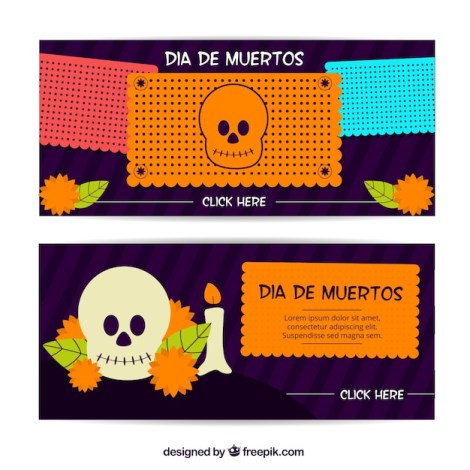Fascinating Facts about Dia de los Muertos

Dia de los Muertos, or Day of the Dead, is a vibrant Mexican holiday celebrated on November 1st and 2nd.
It is believed that during Dia de los Muertos, the souls of the deceased come back to visit their loved ones.
Families create altars called ofrendas to honor their ancestors and decorate them with their favorite foods, photos, and mementos.
Dia de los Muertos is not a solemn or mournful holiday but a joyful celebration of life and death.
The holiday is a unique blend of indigenous Aztec rituals and Catholic beliefs brought by the Spanish conquistadors.
Sugar skulls, or calaveras, are a common symbol associated with Dia de los Muertos. They are intricately decorated and often have the names of the deceased on them.
Marigolds, known as cempasuchil, are the traditional flowers used to decorate altars and graves during Dia de los Muertos. They are believed to guide the spirits back to the living world.
Pan de Muerto, a sweet bread shaped like bones and skulls, is a traditional food made during the holiday. It is often shared with family and friends.
The spiritual essence of deceased children is believed to arrive on November 1st, known as Dia de los Angelitos or Day of the Little Angels.
Families often visit cemeteries and gravesites to clean and decorate the graves of their loved ones during Dia de los Muertos.
The holiday recognizes death as a natural part of the human experience and encourages people to remember and celebrate their departed loved ones.
Fascinating Facts about Dia de los Muertos part 2
Dia de los Muertos is recognized by UNESCO as an Intangible Cultural Heritage of Humanity.
The holiday has gained popularity around the world and is now celebrated in many countries outside of Mexico.
Dia de los Muertos celebrations often include lively parades with music, dancing, and people dressed in colorful costumes.
Catrinas, elegant skeletons dressed in fancy clothes and hats, are a popular image associated with Dia de los Muertos.
The Aztecs celebrated a similar holiday dedicated to the goddess Mictecacihuatl, known as the Lady of the Dead.
Dia de los Muertos coincides with the Catholic holidays of All Saints’ Day and All Souls’ Day.
Families go to great lengths to prepare for Dia de los Muertos, often spending days making decorations and cooking traditional foods.
La Calavera Catrina, a famous image by Mexican artist José Guadalupe Posada, has become an iconic symbol of Dia de los Muertos.
Dia de los Muertos is not a time to be afraid of death but to embrace the cycle of life and honor those who have passed away.
The holiday was featured in the Disney/Pixar movie Coco, which brought international attention to Dia de los Muertos.
It is believed that the souls of the deceased can hear the prayers and songs offered by their loved ones during Dia de los Muertos.
Families often build private altars in their homes, filled with photos and mementos, to welcome the spirits of their ancestors.
The Aztecs believed that death was just another stage in the cycle of life, and Dia de los Muertos is a way to acknowledge and honor that belief.
Day of the Dead celebrations typically include traditional music like mariachi bands and the playing of traditional instruments, such as the marimba and guitar.
Offering the favorite foods and drinks of the deceased is a common part of Dia de los Muertos, as it is believed that the spirits can enjoy the essence of these offerings.
Many Mexican families spend the night at the cemetery during Dia de los Muertos, sharing stories and memories of their departed loved ones.
The holiday is full of vibrant colors, as it is believed that the spirits are attracted to bright hues.
Families also light candles and burn copal incense to guide the spirits back to their earthly homes.
Dia de los Muertos celebrates the belief that death is not the end but a continuation of life in a different form.
The holiday is an opportunity for families to come together and reconnect with their roots and ancestral heritage.
There are regional variations in how Dia de los Muertos is celebrated throughout Mexico, each with their unique traditions and customs.
Sugar skulls are traditionally made from sugar paste and are decorated with icing, glitter, and colorful designs.
Many Dia de los Muertos celebrations include traditional dances, such as the Danza de los Viejitos, a dance representing the cycle of life and aging.
The holiday is a time for storytelling, as families gather to share memories and tales of their deceased loved ones.
Children often participate in parades and wear costumes to symbolize the spirits of the departed.
The holiday provides an opportunity for individuals to reflect on their own mortality and appreciate the importance of cherishing life.
Oaxaca, a city in Mexico, is known for its elaborate Dia de los Muertos celebrations, featuring large-scale displays, street festivals, and art exhibits.
During Dia de los Muertos, families may also leave offerings of tobacco, alcohol, or other objects believed to be enjoyed by the spirits.
The spirits of deceased animals are also honored during Dia de los Muertos, as they are believed to have a connection to the afterlife.
Many families keep a photo of a deceased loved one on their altars year-round, not just during Dia de los Muertos, as a way to keep their memory alive.
The holiday emphasizes the importance of remembering and celebrating lives rather than mourning losses.
Dia de los Muertos is a time for reflection and gratitude for the contributions and influence of those who came before us.
The holiday promotes a sense of community and unity as people come together to honor their shared cultural heritage and history.
Dia de los Muertos serves as a reminder that death is a natural part of life and should be cherished as part of the human experience.